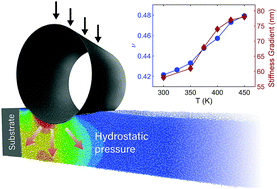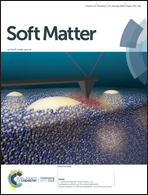Temperature effects on the nanoindentation characterization of stiffness gradients in confined polymers†
Abstract
The stiffening of polymers near inorganic fillers plays an important role in strengthening polymer nanocomposites, and recent advances in metrology have allowed us to sample such effects using local mechanical measurement techniques such as nanoindentation and atomic force microscopy. A general understanding of temperature and confinement effects on the measured stiffness gradient length-scale ξint is lacking however, which convolutes molecular interpretation of local property measurements. Using coarse-grained molecular dynamics and finite element nanoindentation simulations, we show that the measured ξint increases with temperature in highly confined polymer systems, a dependence which acts in the opposite direction in systems with low confinement. These disparate trends are closely related to the polymer's viscoelastic state and the resulting changes in incompressibility and dissipative ability as the polymer transitions from glassy to rubbery. At high temperatures above the glass transition temperature, a geometrically confined system restricts the viscous dissipation of the applied load by the increasingly incompressible polymer. The indentation causes a dramatic build-up of hydrostatic pressure near the confining surface, which contributes to an enlarged measurement of ξint. By contrast, a less-confined system allows the pressure to dissipate via intermolecular motion, thus lowering the measured ξint with increased temperature above the glass transition temperature. These findings suggest that the well-established thin film-nancomposite analogy for polymer mobility near interfaces can be convoluted when measuring local mechanical properties, as the viscoelastic state and geometric confinement of the polymer can affect the nanomechanical response during indentation purely from continuum effects.



 Please wait while we load your content...
Please wait while we load your content...
